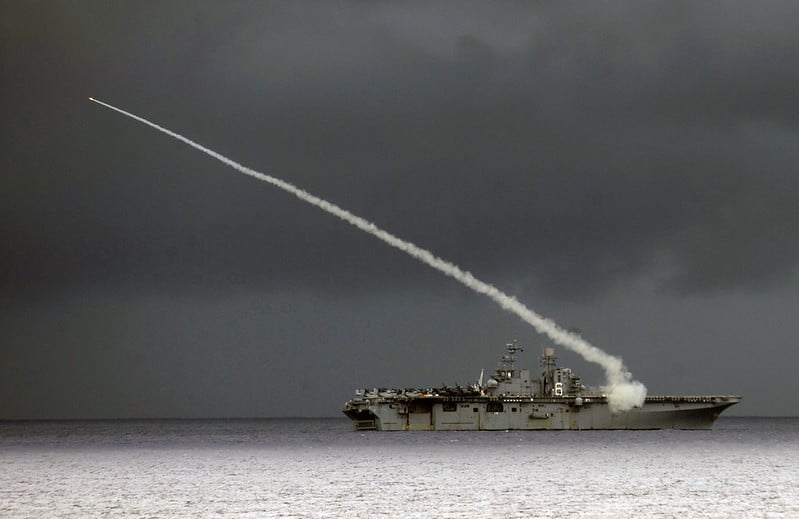April 14, 2016
Aegis Ashore is the land-based variant of the Navy’s Aegis Weapons System and the centerpiece of Phases II and III of the European Phased Adaptive Approach (EPAA). The system incorporates land-based versions of the various components used on Aegis ships, including the deckhouse, AN/SPY-1 radar, the Mark 41 Vertical Launching System (VLS), and Standard Missile-3 (SM-3) interceptors....

June 14, 2018
The Aegis Ballistic Missile Defense (BMD) System, is the sea-based component of the Ballistic Missile Defense System (BMDS). It uses the SPY-1 radar and variants of Standard Missile-3 (SM-3) or Standard Missile-6 to intercept ballistic missiles during midcourse or terminal phases of flight. The system is integrated on certain U.S. Navy Ticonderoga-class Cruisers (CG) and Arleigh Burke-class...
April 14, 2016
The Air and Missile Defense Radar (AMDR), also known as the SPY-6, is a next-generation integrated radar providing both exoatmospheric and air defense, and surface warfare capabilities on U.S. surface ships. The SPY-6 will be featured on the Flight III Arleigh Burke Guided Missiles Destroyers. The radars are slated to be 30 times more powerful...
April 7, 2016
The AN/SPY-1 is a multi-function, phased array, 3D air search radar that provides search, detection, tracking, and discrimination data of air and surface targets. It is the main fire control radar for the Aegis Combat System, which equips both Aegis ships and Aegis Ashore sites located in Poland and Romania. First deployed in 1983, SPY-1...
August 11, 2016
C2BMC Overview The Command and Control, Battle Management, and Communications (C2BMC) system is a hardware and software interface for the ballistic missile defense system (BMDS) that integrates of data from multiple sensors and fire control units. This integration helps to build a common picture of the battlespace for operators across the BMDS, and enables the warfighter...
April 14, 2016
The Defense Support Program (DSP) is a satellite constellation in geosynchronous orbit (GEO) that detects rocket launches and nuclear detonations with infrared sensors. DSP satellites are operated by the U.S. Space Force. DSP’s first satellite launch took place in 1970. Although the constellation remains operational, its military mission is now primarily satisfied by the Space-Based...

July 25, 2017
The RIM-162 Evolved Seasparrow Missile (ESSM) is a medium-range, surface-to-air interceptor designed to counter high-speed antiship cruise missiles naval vessels against antiship cruise missiles (ASCM), low-velocity air threats (LVAT) such as drones and helicopters, and high-speed maneuverable surface threats. The ESSM works in concert with other air defense interceptors, such as Standard Missile-2 and Standard...
August 11, 2016
The Space Tracking and Surveillance System (STSS) is a space-based system developed and operated by the Missile Defense Agency (MDA) that detects and tracks ballistic missiles. This system is an experimental component of the U.S. Ballistic Missile Defense System (BMDS) and STSS serves as a complement to other U.S. space-based platforms and was intended to...
April 14, 2016
The Standard Missile-2 (SM-2) family was developed to provide air and cruise missile defense as part of the Aegis Combat System on U.S. Navy ships. The SM-2 Blocks II, III, and IV each uses semi-active radar homing and have a blast-fragment warhead with a radar and contact fuse. The family of SM-2 interceptors are all solid-fueled and...

June 14, 2016
The Standard Missile-3 (SM-3) is an exo-atmospheric missile defense interceptor used for theater ballistic missile defense. Part of the the Aegis Weapon System, it uses a hit-to-kill kinetic kill vehicle to intercept ballistic missiles during the midcourse of their flight path. SM-3s are unique due to being the only Standard Missile designed to operate in...

April 14, 2016
The Standard Missile-6 (SM-6) is a multi-mission missile capable of antiair warfare, terminal ballistic missile defense, and antiship strike roles. It uses a blast-fragmentation warhead to engage these threats in the endo-atmosphere. The U.S. Navy has also upgraded the SM-6 to perform strike missions. Its tri-mission capability also presents opportunities for the Navy to arrange...



